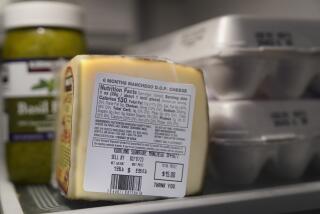Better Health Through Food Labels
- Share via
If American grocery shoppers were to believe everything on today’s food labels, virtually every product on the shelf would be “low fat” and “high fiber.” But what exactly do those terms mean? Finally, consumers’ deciphering days are coming to an end. A welcome proposal from Health and Human Services Secretary Louis W. Sullivan, as well as pending bills in Congress, would require manufacturers to provide full and clear food nutrition information. Unavoidably, we still may be what we eat, but at least now we’ll know precisely what it is we’re eating.
As it stands, food labels are a hodgepodge of information: About 40% of products are not labeled at all, and those that are labeled don’t give the sort of details today’s health-conscious consumers want. The amount of cholesterol, dietary fiber and saturated fat--key information for any healthy diet--is missing from many labels. Serving sizes on which the measurements are based are not standardized. Nutritional labels, which have not been revised significantly in 17 years, have become increasingly confusing and inconsistent. The grocery store, as Sullivan put it, “has become a Tower of Babel.”
Sullivan’s proposal to have the Food and Drug Administration clarify and expand labeling should begin to take effect at the end of 1991. According to some consumer groups, legislation by Rep. Henry A. Waxman (D-Los Angeles) and Sen. Howard M. Metzenbaum (D-Ohio) would accomplish the same goals faster. The sooner the better; the FDA and Congress should be encouraged to speed up the process to help consumers make informed (if not guilt-free) decisions about what they eat, be it oatmeal and fruit--or cookies and frozen pizza.





